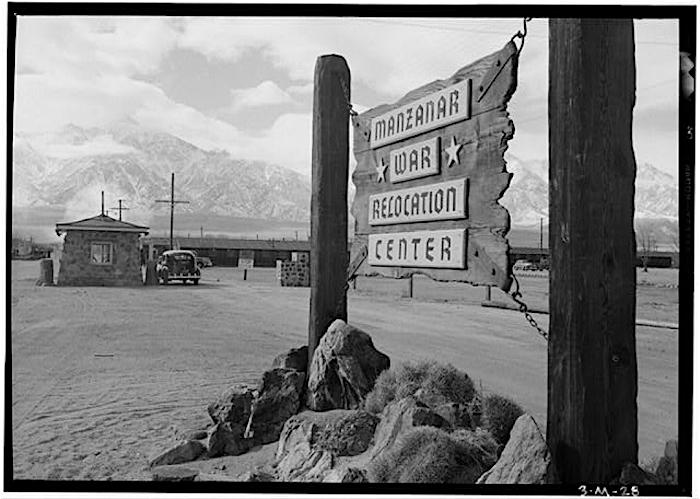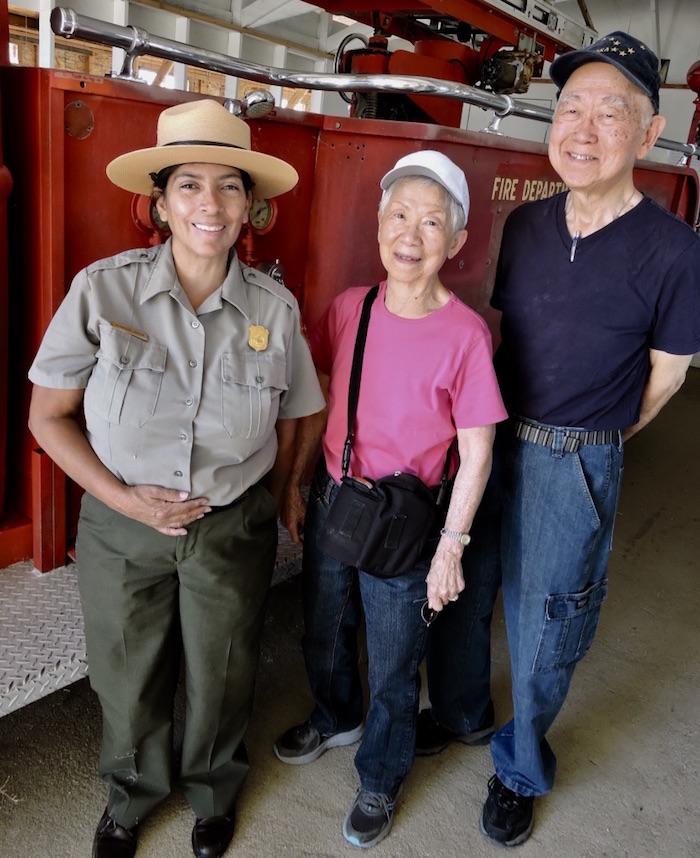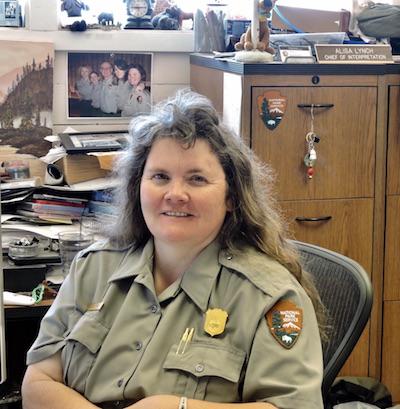
Entrance sign to Manzanar War Relocation Center/Ansel Adams
Manzanar National Historic Site, located in the Owens Valley of California just east of Death Valley has long been on my list of must places to visit. So when weather abruptly changed some travel plans and sent me south from Lake Tahoe, I wound up unexpectedly in Manzanar.
Then I learned it was only a week until the 49th Manzanar Pilgrimage would bring a gathering of Japanese who had been interned here in days of American panic following December 7, 1941. Most will be people who, like me, were very young at the time. They and their children and grandchildren come to Manzanar every year to try to ensure that we never forget a time when unreasoned fear swept our land. It sucked tens of thousands of Japanese, a majority of them American citizens, out of their homes, businesses, and lives and flushed them into ten “War Relocation Centers.” Now they gather to try to keep memory alive in hopes it will never happen again.
I decided to stick around. It sounded exciting and interesting. Perhaps a chance to meet real players in our history. So it was that I walked into the visitor center and asked if there was anything I could do to help. In just a minute or two I was talking with Sarah Bone, the ranger who is the site’s Volunteer in the Parks coordinator. I knew I was taking potluck and maybe asking a lot considering the upcoming big special event. I was afraid I’d be more in the way than helpful.
“What are you willing to do?” she asked.
“Anything,” I replied. “Well, almost anything . . . “
She said she’d ask all the division heads, took my phone number and promised a call back. Sure ‘nuff, it wasn’t long before I had an appointment to sit down with facility manager Jim Baker. A day later, I was reporting for duty, complete with a pair of leather gloves, a canteen, and no real idea what to expect.
Paperwork first. Not complicated. Basically only who to call and where to send my body just in case.

Manzanar Superintendent Johnson and former detainees Anna and Sabaro Sasama/Lee Dalton
Then I was introduced to a young guy named Daron Hayes. We were going recycling. Two trips dragging trailers full of recyclables to Fort Independence Paiute Reservation’s recycling center and back. I could help hook up and unload.
Like so many NPS folks, Daron spent a long time bouncing from season to season and place to place before landing at least a semi-permanent job. He’d make a terrific interpretive ranger, but for now any chance to wear the Arrowhead will do. So he’s one of that army of men and women who actually keep our parks operating and clean — without much credit.
I discovered along the way that he’s a darn good interpreter, too. He pointed out a large hawk that I’d missed seeing. He introduced me to some of the plants growing along the road. Then he stopped to urge a big bull snake over to the road shoulder and away from tires.
I learned how hard it is just to find an affordable place to live anywhere near one of our parks and was left thinking how lucky we, and our parks, are to have people like Daron around.
Just before noon, Daron handed me off to Patricia Biggs (PhD), a historian who is one of Manzanar’s primary interpretive rangers. We spent the day in one of the long tarpaper barracks that once housed families and strangers crammed together into hot, dusty, cold, flimsy buildings that would be their homes for the war’s duration. Our mission today was to replace worn temporary exhibits with more temporary exhibits telling the story of Manzanar’s schools.

Daron Hayes does one of those thankless, behind-the-scenes jobs in the National Park System/Lee Dalton
My first assignment was dusting off a night’s accumulation of sandy dust from everything. Happily, Daron had already cleaned a mountain of mouse droppings and nests (can you say Hanta virus?) from under and inside the teacher’s desk. It was hot. Uncomfortable. Just as it had been for the kids who once studied in a place like this. And it was only a mild spring day. Summer is still on the way. Patricia is a bundle of energy. She kept me hopping all afternoon.
As we worked, she explained that the displays we were installing with staples and thumbtacks will someday be replaced with permanent display panels. But they’ve been delayed and the Pilgrimage is here now. Things have changed in the National Park Service with modern technology. These new displays had been designed and prepared with a lot of hard work by local staff led by Patricia and Chief of Interpretation Alisa Lynch. They wrote the text, gathered and scanned old photos and documents, designed and printed the layouts on the site’s large format printer. The displays were real testimonies to local talent and hard work. The only difference is that future displays will be much more durable.
When we finished, I was plumb exhausted.
Wednesday and Thursday are Patricia’s days off. Truth to tell, I was kind of relieved. Not sure I could have kept up with her for another day.

Historian Patricia Biggs develops many of the interpretive displays at Manzanar/Lee Dalton
The second morning started with Jim Baker again. He needed to have a batch of radio serial numbers recorded and radio call lists taped to them. Then Administrative Assistant Katie Busch put me to work making up nametags for media reps and special guests at the Pilgrimage. People kept apologizing, saying they were sorry they didn’t have anything more valuable or interesting for me to spend my time on. After all, there were other volunteers doing much more exciting things like manning the information desk or preparing some of the old Japanese gardens to look more presentable to visitors this weekend.
Is there such a thing as calm chaos? Here were a bunch of people working like mad to have everything ready for the Big Weekend. But there was no sense of emergency. No panic. No short tempers. Lots of laughter and banter. Teamwork. That’s what it was. In the midst of all this an older lady — Japanese — came in with a box full of family memories she was prepared to donate. I watched from a distance as she went through the box.
Then, the next assignment. A big box full of 540 Manzanar mini-folders and many boxes of informational flyers that needed to be collated and turned into as many School Packets as time would allow. Packets to be mailed to school children or teachers who wrote asking for information. I set up shop on what had been the stage of the Manzanar community center and went to work. Fold flyers that weren’t already folded. Schlep seven flyers and a mini-folder together, wrap ‘em with a rubber band and do it again. And again, and again . . .
That’s how I spent Wednesday afternoon and all of Thursday. Only managed to finish maybe 350 of them, but it was a pleasantly cool place to work and almost everyone who ventured past said something like, “Oh! You’re doing that! Wonderful!”
Like so many other parks, Manzanar has been forced to make do. They have an old building that wasn’t intended for offices. Now their offices are tiny cubbyholes ranging along a very narrow hallway. Kind of reminded me of the latrines internees had to use back in the day. Crowded with no privacy and no quiet.
But they do it. Somehow.
I’m not sure if it was Katie or Sarah Bone who finally said to me, “You know, none of what we’re asking you to do is really fun or exciting, but it’s all stuff that desperately needs to be done. Stuff none of us seem to find time to do. You have no idea how much we appreciate you.”
I already knew that. It was obvious. Even to a befuddled old guy like me. They just didn’t know how valuable they were making me feel.
======
The big day finally arrived, and I had a front-row seat. I really enjoyed the opportunity to tag along with Superintendent Johnson as she took Sabaro Sasama and his wife, Anna, on a special tour of the fire station. Mr. Sasama had been interned here as a child before moving on to settle in Cleveland, Ohio. He pointed out his older brother in a photo of internees who had served as firefighters in the camp, and shared fascinating stories of his experiences. Today, the Sasamas serve as some of the former internees who help tell the camp’s stories and preserve its human history.
Later it was out to the cemetery for a couple of hours of traditional Japanese music, and speakers who recounted not only experiences they had had here long ago, but contemporary speakers urging us all to pay greater attention to what’s happening in the world around us — and to be ready to stand up for what is right.

Manzanar Chief of Interpretation Alisa Lynch/Lee Dalton
I had the chance to meet one of the men who had left Manzanar to become a soldier in the 442nd Combat Infantry Team. Lawson Sakai is now a trim and spry and very active 94 years old and a very proud member of the American Legion. He earned a Silver Star and two Purple Hearts in combat in France. Today, he’s a member of the Manzanar Committee and was honored to carry the 442nd Regimental Flag into the ceremonies. I felt deeply honored to be able to speak to him.
Then there were short interdenominational religious services. A Christian minister who had been interned here led the assembly in prayer. Then a young Buddhist minister led everyone who spoke Japanese in prayers.
I haven’t been so touched by anything in a very long time. It was something I wish more Americans could witness. We need things like this.
======
It was a week I’ll remember for a long time.
And so, gentle Traveler reader, if you’ve ever thought about volunteering in one of our parks . . . do it!
You’ll be glad you did.



Comments
Lee, what a wonderful story! You make me feel like I was right there with you. Kudos to all of these people who make do with what they have and make it all work, and kudos to the volunteers who care so much about our national parks.
Lee --- So well written, and I can't tell you how much I envy your opportunity to meet and talk with Mr Sakai and Mr & Mrs Sasama. I would think it was similar for you to when I had the honor to meet with some of the Tuskegee Airmen. American citizens who our nation once dishonored who we now honor.
Thanks for the report. I visited Manzanar many years ago, before there was much interpetive information there. Maybe it's time to revisit!
Wonderful story written with heart!
Thank you for your service, Lee.
Danny Bernstein
national Parks Service is a real treasure! Wonderful reflection. Thank you.